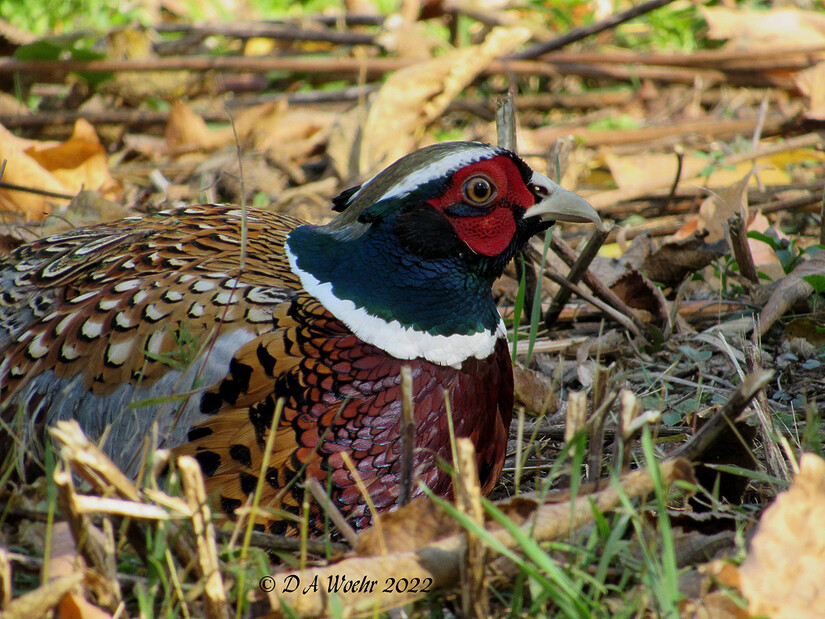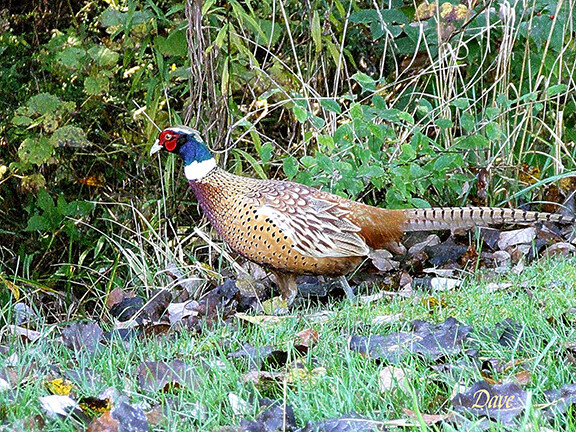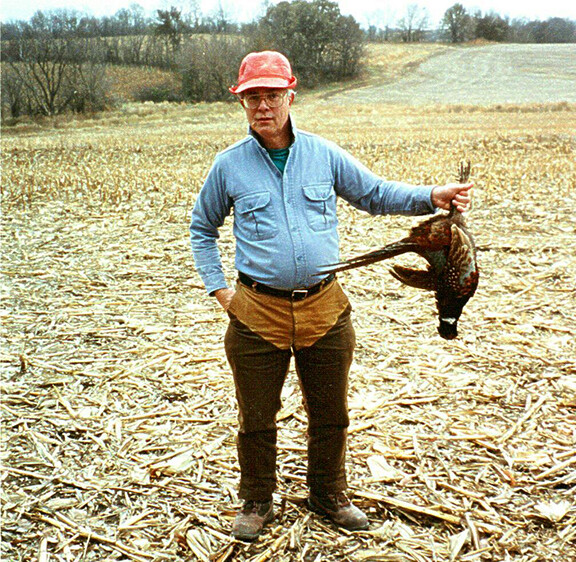Image

LEBANON, OH -- Today we’re going to take a look at a game bird, the Ring-necked Pheasant. The pheasant may be the most popular upland game bird across the country among hunters. In its heyday, the pheasant’s range extended across much of the United States except for the southern states.
In Ohio, it was well-established in the northern and western agricultural region where ancient glaciers had deposited deep tillable soils that were rich in minerals that pheasants seem to enjoy in their diet. But time has passed, and changes in farming methods and land use have largely reduced the population and range of the pheasant in Ohio to a few counties in the central and far northwestern parts of the state. Across the country, the pheasant’s main stronghold today is the area between the Rocky Mountains and the Mississippi River. Kansas, Nebraska, and the Dakotas now have the densest pheasant populations. It is the state bird of South Dakota.
The Ring-necked Pheasant is a large bird. The male, known as a cock or rooster, weighs up to three pounds. Roosters are very gaudy, sporting a rainbow of iridescent blue, green, gold, brown, and gray feathers, some edged and flecked in black or white. They have a green head, a red face, a white neck ring, “ear tufts” like a Great-horned Owl, and tail feathers up to two feet long!
 With a rooster Ring-necked Pheasant
With a rooster Ring-necked PheasantThe female is called a hen. Hens weigh about two pounds and are less flashy dressers. Their feathers are light brown flecked with black. They do not have the red face or white neck ring. This drab color arrangement for the hen is nature’s way of providing her with camouflage. She is a ground nester and wants to be unseen as she moves to and from her nest in unmowed grassy areas where she hides a clutch of a dozen eggs or more. Being chicken-like fowl, pheasants roost and feed on the ground. In very wet or icy weather they will sit on fence tops attempting to stay dry, but they seldom fly up into a tree. They are ground huggers.
When the pioneers made their westward advance across the Appalachian Mountains and onward to the Great Plains, they didn’t see a single pheasant. They saw grouse, quail, turkeys, and partridges, but no pheasants. That’s because the pheasant is not native to North America. It is an Asian bird that was introduced to the United States from China solely for the sport of hunting.
Visitors to China saw the pheasant in its native land and dreamed of importing it to America for sport shooting and as a food source. In the late 1800’s and early 1900’s pheasants were brought in and released in Washington and Oregon. They thrived and many were eagerly trapped by wildlife officials and moved into suitable habitat in other states, Ohio among them.
In my childhood days, America’s farms were mostly family farms of 40 acres or so. They were separated by brushy fencerows and contained drainage ditches that grew up in weeds and grasses that were ideal cover and nesting habitat for pheasants. In those long-ago times, my family frequently made the six-hour drive across northern Ohio from our home in Pennsylvania back to Indiana to visit relatives. To make the trip seem less tedious, we used to keep our eyes peeled looking for pheasants in the fields as we drove across the state.
We always saw pheasants on the farms looking for spilled grain and insects to eat. And as recently as 30 years or so ago, I was still seeing a few wild pheasants in Highland and Ross Counties just to the east of us. That’s not a sight to be enjoyed anymore.
Small family farms have been gobbled up and combined into vast mega-farms. Brushy fencerows have been eliminated and drainage ditches are kept clean. Crops are planted to the very edges of highways and byways seemingly without a square inch of tillable ground left unplowed. Long ago, corn and wheat stubble used to be left in the crop fields until spring. Now it is plowed under immediately after the fall harvest. In short, modern farming methods have reduced nesting cover, winter habitat, and food supplies for pheasants as well as for many other species of upland game and wildlife.
 I found this cock pheasant strolling along the edge of a dense thicket getting some sun on a cool October morning.
I found this cock pheasant strolling along the edge of a dense thicket getting some sun on a cool October morning.Even though Ohio’s population of wild pheasants has dwindled to an all-time low, hunters can still enjoy bagging a bird or two for Thanksgiving dinner courtesy of the state’s pheasant stocking program. The Department of Natural Resources pen-raises about 15,000 birds each year and releases them throughout the fall in wildlife areas such as Caesar Creek State Park in Warren County, Indian Creek Wildlife Area in Brown County, Rush Run Wildlife Area in Preble County, Fallsville Wildlife Area in Highland County, and the Spring Valley Wildlife Area north of Waynesville.
Thus, today’s generation of Ohio hunters can still enjoy the sport of pheasant hunting in the field with their Shorthair Pointers, Brittany Spaniels, and other bird dogs. Nearly all stocked pheasants are harvested by hunters, and few winter over. Although pheasants can attain a flight speed of 40-50 miles per hour and glide for a mile or more after attaining altitude, they flush with a relatively slow and cumbersome start like a helicopter taking off with a broken rotor. And when they flush they let out a squawk or cackle as irritating as that of any peacock I’ve ever heard.
Many youngsters new to hunting enjoy their first successful wing-shooting experiences thanks to the Ring-necked Pheasant. Only cock birds can be legally taken, and no more than two per day here in Ohio. Pheasants are excellent runners and would prefer to escape hunters and dogs by running through the brush and cover rather than taking to the air. They’re sneaky and elusive. Many avoid a 12-gage shotgun blast simply by running away through heavy undergrowth.
Because there are so few wild pheasants in Ohio anymore, it is hard to find opportunities to photograph them in a natural setting. Nevertheless, I have happened to have my camera handy on a couple of occasions when I unexpectedly came upon a roadside pheasant and could snap a picture before he disappeared into an impenetrable thicket.
 An old photo of me from about 1990 on a pheasant hunt in Page County, Iowa near the town of College Springs.
An old photo of me from about 1990 on a pheasant hunt in Page County, Iowa near the town of College Springs.My L. L. Bean Game and Fish Cookbook has plenty of delicious sounding recipes for making the pheasant the centerpiece of a game dinner. Included among them are Pheasant Flamed with Apples, Roast Pheasant with Wild Rice and Mushrooms, Baked Pheasant Breast in Orange Sauce, Stewed Pheasant with Sage Dumplings, and Pheasant Pot Pie. Thinking back, I can recall many wonderful game dinners with my family and friends, and pheasant was the table fare from time to time. For me, these events are now just pleasant memories of wild game dinners from the bounty of Nature Close to Home.